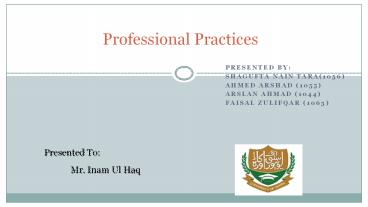Intellectual Property Rights - PowerPoint PPT Presentation
Title:
Intellectual Property Rights
Description:
An Introduction – PowerPoint PPT presentation
Number of Views:228
Title: Intellectual Property Rights
1
Professional Practices
- Presented by
- Shagufta Nain Tara(1056)
- Ahmed Arshad (1055)
- Arslan Ahmad (1044)
- Faisal Zulifqar (1063)
Presented To Mr. Inam Ul Haq
2
Intellectual Copy right
3
Contents
- What is Intellectual Copy right
- Two main areas of Intellectual Copy right
- Copyright and rights related to copyright
- Industrial property.
- Summary
- References
4
Intellectual Copy right
- Intellectual property rights are the rights given
to persons over the creations of their minds.
They usually give the creator an exclusive right
over the use of his/her creation for a certain
period of time.
5
Intellectual property rights are customarily
divided into two main areas
Copyright and rights related to copyright.
Industrial property
6
Copyright and rights related to copyright.
- The rights of authors of literary and artistic
works (such as books and other writings, musical
compositions, paintings, sculpture, computer
programs and films) are protected by copyright,
for a minimum period of 50 years after the death
of the author.
7
- Also protected through copyright and related
(sometimes referred to as neighboring) rights
are the rights of performers (e.g. actors,
singers and musicians), producers of phonograms
(sound recordings) and broadcasting
organizations. The main social purpose of
protection of copyright and related rights is to
encourage and reward creative work
8
Industrial property
- Industrial property can usefully be divided into
two main areas - 1) One area can be characterized as the
protection of distinctive signs, in particular
trademarks (which distinguish the goods or
services of one undertaking from those of other
undertakings) and geographical indications (which
identify a good as originating in a place where a
given characteristic of the good is essentially
attributable to its geographical origin).The
protection of such distinctive signs aims to
stimulate and ensure fair competition and to
protect consumers, by enabling them to make
informed choices between various goods and
services. The protection may last indefinitely,
provided the sign in question continues to be
distinctive.
9
- 2) Other types of industrial property are
protected primarily to stimulate innovation,
design and the creation of technology. In this
category fall inventions (protected by patents),
industrial designs and trade secrets.The social
purpose is to provide protection for the results
of investment in the development of new
technology, thus giving the incentive and means
to finance research and development
activities.A functioning intellectual property
regime should also facilitate the transfer of
technology in the form of foreign direct
investment, joint ventures and licensing
10
The protection is usually given for a finite term
(typically 20 years in the case of patents).
- While the basic social objectives of intellectual
property protection are as outlined above, it
should also be noted that the exclusive rights
given are generally subject to a number of
limitations and exceptions, aimed at fine-tuning
the balance that has to be found between the
legitimate interests of right holders and of
users
11
SUMMARY
- What is Intellectual Copy right
- Two main areas of Intellectual Copy right
- Copyright and rights related to copyright
- Industrial property.
12
REFERENCES
- https//www.wto.org/english/tratop_e/trips_e/intel
1_e.htm - Armbrust, M., Fox, A., Grif?th, R., Joseph, A.
D., Katz, R. H., et al. (2009). Above the clouds
A berkeley view of cloud computing, Electrical
Engineering and Computer Sciences University of
California, Berkeley, (Technical Report No.
UCB/EECS-2009-28). http//www.eecs.berkeley.edu/Pu
bs/TechRpts/2009/EECS-2009-28.html,
13
(No Transcript)

